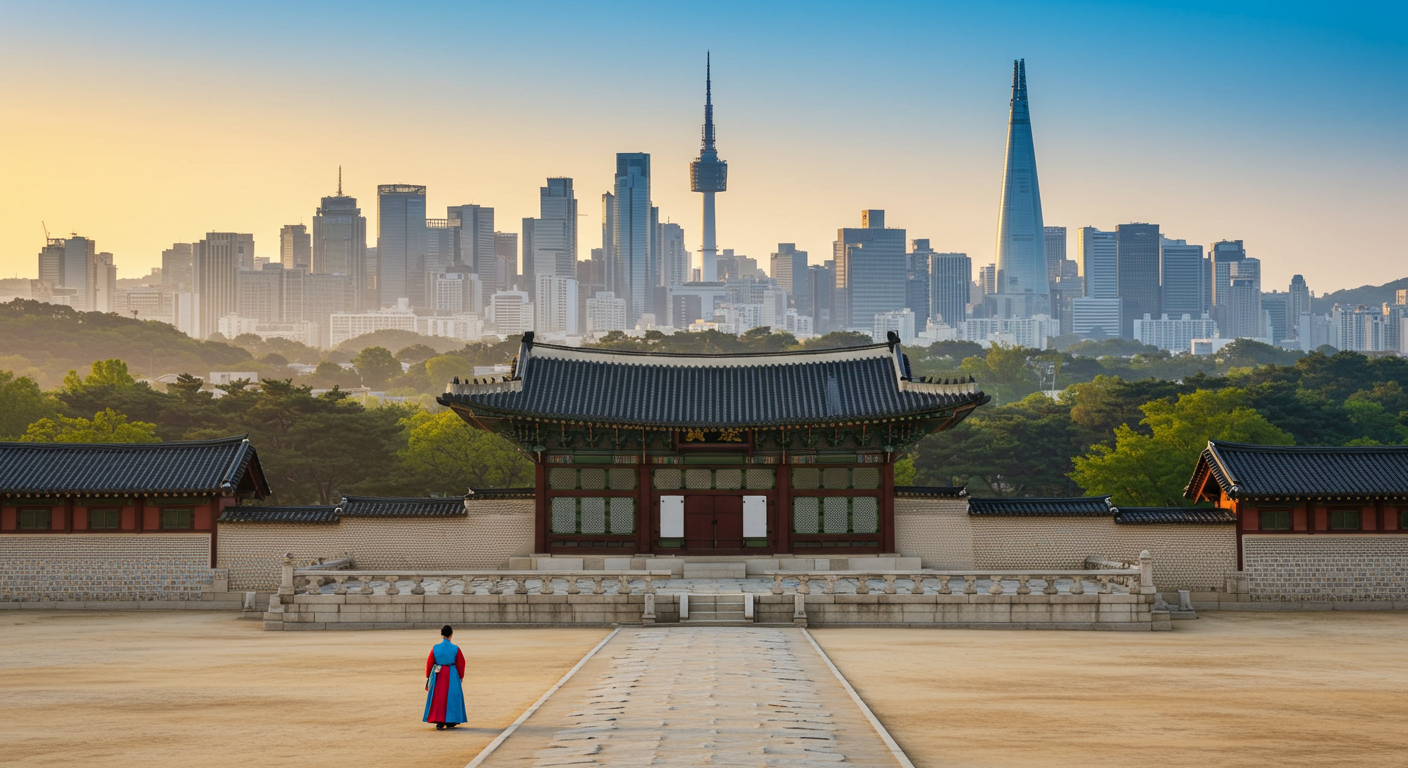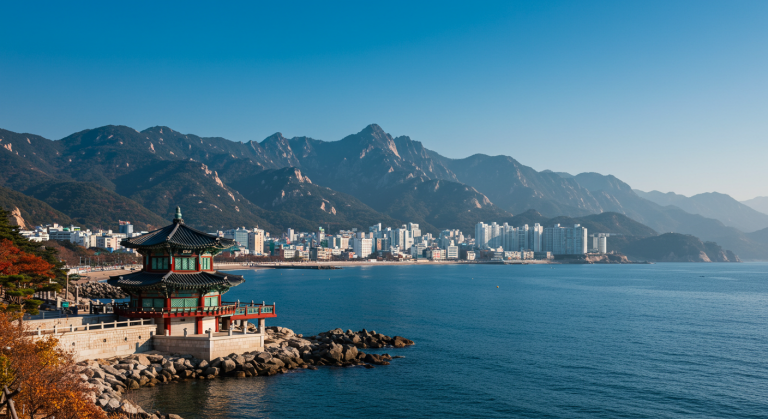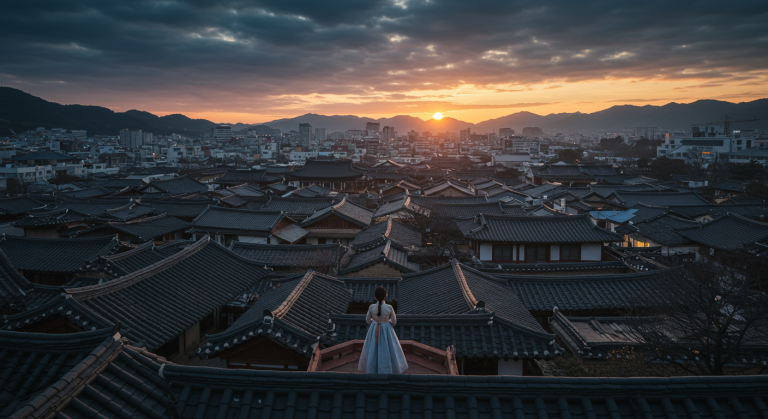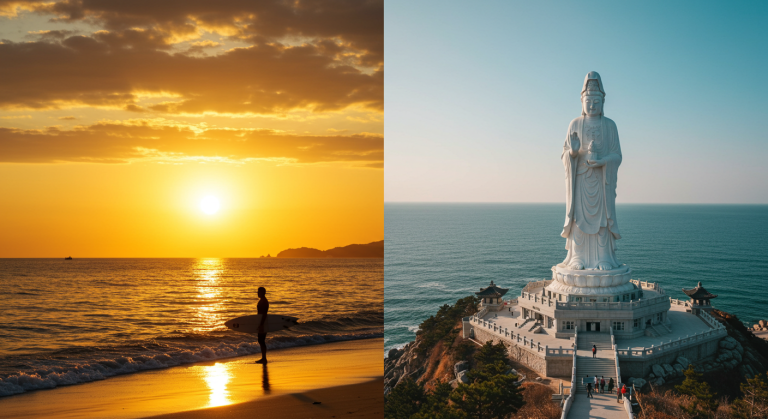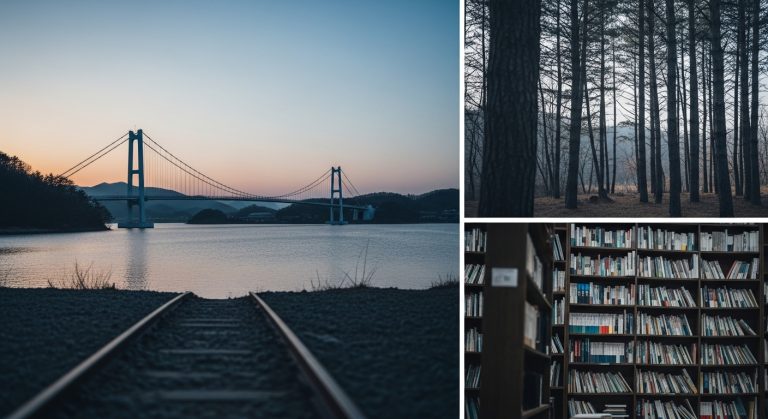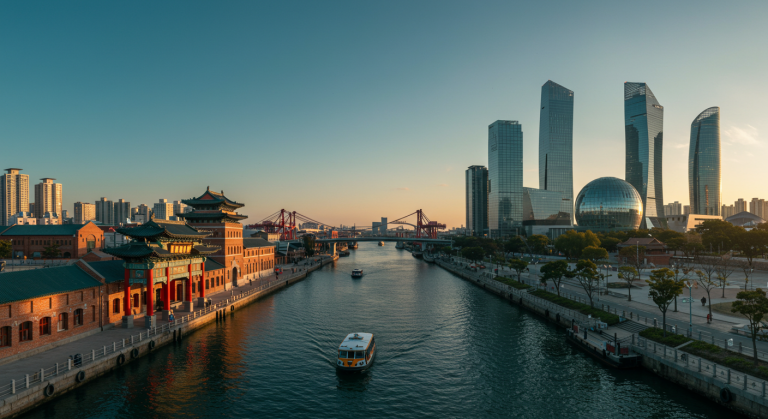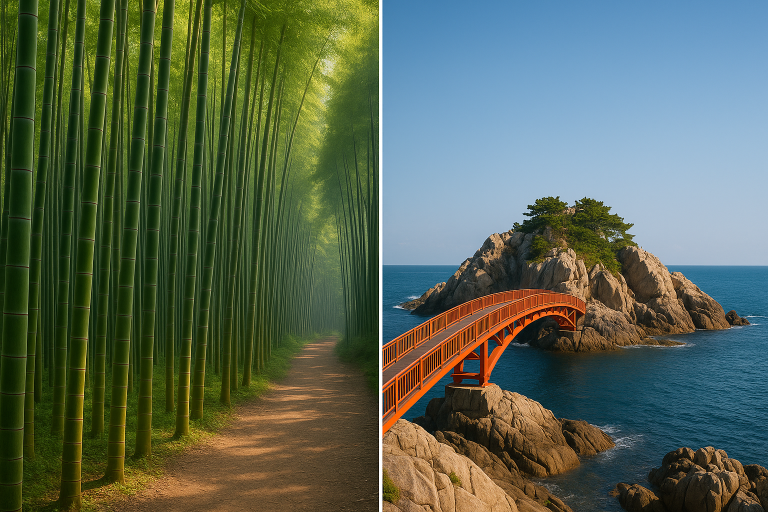Jeju’s Four Seasons Unlocked: A Deep Dive into Where to Go and What to Eat
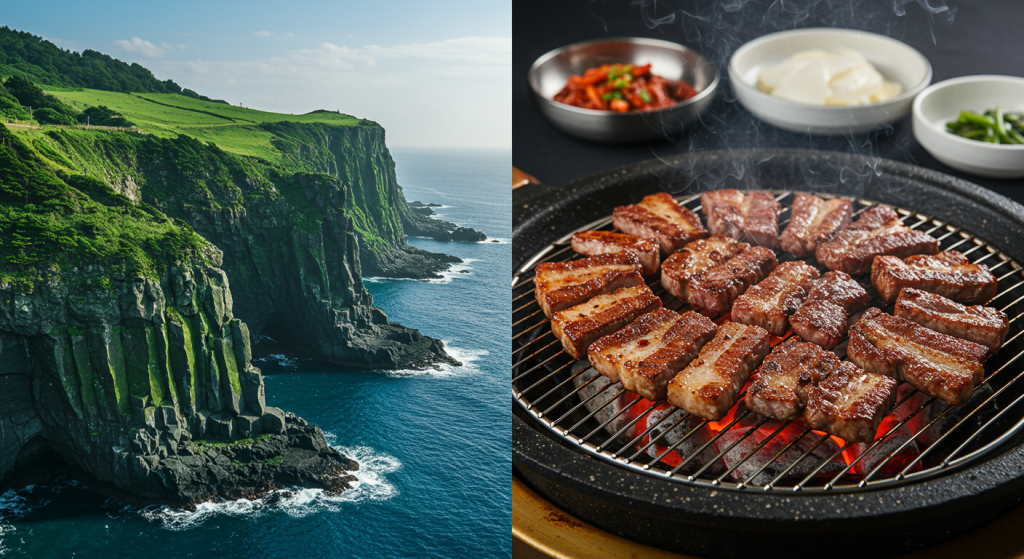
Have you ever felt overwhelmed trying to plan a trip to a place that literally has it all?
I know the feeling. Jeju Island, South Korea’s breathtaking volcanic paradise, is one of those places where the sheer number of incredible sites can make itinerary planning feel like a monumental task.
But don’t worry, that’s exactly why I’ve put together this comprehensive, region-by-region guide!
We’re going to break down the island’s best **must-visit spots** so you can seamlessly design a trip that fits your style, whether you’re chasing sunrises or savoring slow coffee culture. Trust me, by the end of this article, your perfect Jeju adventure will be ready to go! 🗺️
Section 1: The Iconic North & West Coast Vibe 🏖️
The northern and western parts of Jeju offer a fascinating mix of urban sophistication and wild, untouched coastline.
This area is generally easier to navigate and is home to the island’s main airport, making it a great starting point for any trip.
**Aewol Coastal Road & Café District**
If you’re looking for the heart of modern Jeju’s travel trends, head straight to **Aewol**.
The coastal road here is famous for its picturesque views and, more importantly, its density of beautiful, trendy cafes built right over the turquoise water. I always stop at one of the famous **Aewol cafes** just to watch the waves crash—it’s the ultimate chill spot.
**Hallasan National Park**
Standing proud in the center of the island is **Halla Mountain**, a dormant volcano and South Korea’s highest peak.
Climbing to the summit is absolutely a bucket-list item for serious travelers, offering unparalleled views and a gorgeous crater lake, Baekrokdam. Remember, this is an all-day commitment, so plan accordingly!
Only the Gwanuemsa and Seongpanak trails lead to the summit. For a day trip, start **before 8 AM** in peak season (earlier in winter) as entrance cutoff times are strictly enforced. Make sure you book your entry pass in advance online!
Section 2: The Majestic East – Sunrise and Volcanic Formations 🌅
The East side of Jeju is defined by its dramatic volcanic geology and the promise of a spectacular sunrise.
It’s here you’ll find the two most famous UNESCO World Heritage Sites related to the island’s volcanic past.
**Seongsan Ilchulbong Peak**
Also known as Sunrise Peak, this tuff cone is arguably the most famous **Jeju must-visit spot**.
Waking up early to hike the short, steep path and witness the sun rising over the ocean and the surrounding volcanic terrain is a truly unforgettable experience.
**Manjanggul Lava Tube**
Go underground and explore a geological marvel!
The **Manjanggul Lava Tube** is one of the finest and longest lava tunnels in the world open to the public, offering a cool, dark journey into the island’s fiery past. The huge lava column at the end is impressive, but remember to dress warmly—it’s chilly down there!
A less-visited but equally charming destination is **Udo Island**, a small landmass easily reachable by ferry from Seongsan Port.
It’s perfect for a day trip where you can cycle or scooter around the entire island, enjoying white-sand beaches and famous peanut ice cream. Udo is the epitome of tranquil island life.
**East Jeju Site Comparison**
| Destination | Primary Experience | Time Needed (Est.) |
|---|---|---|
| Seongsan Ilchulbong | Iconic crater views and sunrise viewing (very popular). | 1.5 – 2 Hours |
| Manjanggul Lava Tube | Geological education and unique cave exploration (cold!). | 1 Hour |
| Udo Island | Relaxed cycling/scootering, slow island pace, unique beaches. | Half to Full Day |
Section 3: The Serene South – Waterfalls and Powerful Cliffs 🌊
The Southern region, centered around Seogwipo City, is known for its dramatic coastline featuring stunning cliffs and waterfalls that seem to pour directly into the ocean.
This area offers some of the most luxurious resorts and a warmer, more tropical feel.
**Jeongbang Waterfall & Cheonjiyeon Waterfall**
You absolutely cannot miss **Jeongbang Waterfall**, one of the only waterfalls in Asia to fall directly into the sea—it’s a powerful sight!
Nearby, **Cheonjiyeon Waterfall** offers a more tranquil, inland setting surrounded by lush, sub-tropical vegetation, making it perfect for an afternoon stroll.
**Jusangjeolli Cliff**
Prepare to be amazed by the geometric perfection of the **Jusangjeolli Cliff**.
These towering hexagonal column formations, created when lava cooled rapidly in the sea, look like gigantic pieces of abstract art carved into the shore. It’s truly a geological masterpiece and a highly recommended photo spot!
While viewing the Jusangjeolli Cliff, always stay behind the designated safety railings. The coastal paths can become extremely slippery and dangerous, particularly during high tides or after rainfall. Never attempt to climb down to the rocks for a better view.
Section 4: Deep Dive into Culture, Food, and The Olle Trail 🚶♀️
Jeju is so much more than its landscapes; it has a rich, independent culture shaped by the sea and its volcanic isolation.
To truly experience the soul of the island, you need to step away from the major tourist hubs and immerse yourself.
**Jeju Olle Trail System**
The **Jeju Olle Trail** is a network of 26 scenic coastal and inland paths that loop around the entire island.
These trails range from easy strolls to challenging hikes, allowing you to discover hidden villages and breathtaking views at your own pace. I personally love Route 7—it offers spectacular views of the southern coast!
**Example Box: The Haenyeo (Jeju’s Female Divers)**
**Case Study: Jeju’s Iconic Haenyeo Culture**
- **Cultural Significance:** The Haenyeo (sea women) are female free divers who harvest seafood without the aid of oxygen masks, representing Jeju’s strong matriarchal society and unique resilience.
- **UNESCO Status:** Their diving culture was inscribed as a **UNESCO Intangible Cultural Heritage** in 2016, recognizing its historical value and distinctive community practices.
- **Visitor Experience:** You can witness their demonstrations at Seongsan Ilchulbong or visit the **Haenyeo Museum** in Gujwa-eup to learn their fascinating history.
Section 5: Interactive Jeju Day Planner 🧮
Use this simple planner to estimate how many days you need based on the key regions you want to explore.
Just select the areas of interest and click calculate to get a recommended trip length!
Have you ever felt overwhelmed trying to plan a trip to a place that literally has it all?
I know the feeling. Jeju Island, South Korea’s breathtaking volcanic paradise, is one of those places where the sheer number of incredible sites—from towering mountains to turquoise seas and bustling markets—can make itinerary planning feel like a monumental task.
When I first visited, I spent hours just staring at the map, wondering where to even start!
But don’t worry, that’s exactly why I’ve put together this comprehensive, region-by-region guide! We’re not just covering the famous spots; we’re diving deep into the **hidden culinary gems**, the most scenic **Olle Trail routes**, and practical **transportation tips** that only locals know. Trust me, by the end of this article, your perfect, fully customized, long Jeju adventure will be ready to go! 🗺️
Section 1: The Vibrant North & Trendy West (City Buzz and Coastal Chic) 🏙️
The northern and western parts of Jeju are the gateway to the island, blending the convenience of Jeju City (제주시) with the island’s most fashionable coastal lines.
This area is perfect for travelers who enjoy a mix of culture, great food, and stunning sunsets over the sea.
**Jeju City: Urban Convenience and Culture**
Your journey likely starts here, and Jeju City is worth more than just a quick drive-through.
It’s the best place to experience the island’s daily life and indulge in some serious local cuisine right off the plane.
- **Dongmun Market (동문시장):** A must-visit traditional market offering everything from fresh seafood caught that morning (try the *Hanchi* squid!) to local tangerine products and street food. The night market section is particularly lively.
- **Black Pork Street (흑돼지거리):** Located near the market, this street is dedicated entirely to Jeju’s famous **Black Pork** (흑돼지). The intense flavor and chewy texture of this local delicacy are unforgettable.
- **Sarabong Peak (사라봉):** A gentle hike near the city offering panoramic views of Jeju City, the airport, and the ocean—a perfect spot for a city sunset without the mountain commitment.
**The Western Coastal Vibe: Aewol and Beyond**
Heading west from the city, the coastline transforms into a series of stunning beaches and trendy hangout spots.
The **Aewol Coastal Road (애월해안도로)** is the epicenter of Jeju’s modern cafe and relaxation culture, defining the **coastal chic** aesthetic of the island.
While Aewol has great views, for pure beach relaxation, head slightly further to **Gwakji Gwamul Beach (곽지과물해변)** or **Hyeopjae Beach (협재해변)**. Hyeopjae, with its white sand and views of Biyangdo Island, is a photographer’s dream!
Section 2: The Majestic East – Volcanic Icons and Deep Forests 🌋
The East side is Jeju’s geological museum, home to the most dramatic and famous volcanic remnants that secured the island its **UNESCO World Heritage status**.
It’s an area for early risers, nature photographers, and deep cave explorers.
**The Holy Trinity: Sunrise, Underground, and Offshore**
If you only have time for three spots on the East side, these are the heavy hitters you can’t skip.
The sheer scale and natural power of these sites will give you a profound appreciation for the forces that shaped Jeju.
- **Seongsan Ilchulbong Peak (성산일출봉):** The iconic **Sunrise Peak**. The 20-minute morning climb is worth every step, culminating in a view of the enormous crater bowl and the endless East Sea.
- **Manjanggul Lava Tube (만장굴):** A massive, preserved lava tunnel—a genuinely unique experience. The temperature inside hovers around 11-15°C (52-59°F) year-round, so it’s a cool escape in summer, but be prepared for the chill!
- **Udo Island (우도):** Just a 15-minute ferry ride from Seongsan Port, this small island’s name means “Cow Island” due to its shape. Rent an electric scooter or bike to circumnavigate it, enjoying its famous peanut ice cream and spectacular emerald beaches.
**The Inner Forest Trails: Saryeoni and Bijarim**
Away from the coast, East Jeju boasts stunning inland forests that offer tranquility and shade.
These are excellent places to reconnect with nature, especially on a hot or cloudy day.
**Forest Path Comparison**
- **Saryeoni Forest Path (사려니숲길):** Known for its straight, towering cedar and cypress trees. It’s wide, easy to walk, and offers deep forest immersion—perfect for a long, meditative stroll.
- **Bijarim Forest (비자림):** Home to over 2,800 nutmeg trees (Bija), some hundreds of years old. The path is slightly rougher but takes you through an ancient, magical forest with incredibly clean air.
The ground inside the Manjanggul Lava Tube is uneven, dark, and often wet. Wear sturdy shoes with good grip and definitely bring a light jacket, even in summer, to counteract the temperature drop!
Section 3: The Serene South – Waterfalls, Cliffs, and Seogwipo 💧
The Southern region, centered on **Seogwipo City (서귀포시)**, is characterized by its dramatic cliff formations, deep blue waters, and magnificent waterfalls.
It’s geographically warmer than the north, making it an excellent base for winter travel and year-round outdoor exploration.
**The Trio of Waterfalls**
Seogwipo is famously home to three major waterfalls, each offering a distinct experience.
They are all relatively close to each other, making them easy to visit in a single morning or afternoon.
Waterfall Quick Guide
- **Jeongbang Waterfall (정방폭포):** The most unique; it plunges directly into the ocean. The must-see for sheer spectacle.
- **Cheonjiyeon Waterfall (천지연폭포):** The most accessible, set in a peaceful sub-tropical valley. Ideal for a slow, gentle walk.
- **Cheonjeyeon Waterfall (천제연폭포):** Named the ‘Pond of the Emperor of Heaven.’ It features three tiers and the iconic Seonimgyo Bridge, perfect for dramatic photos.
**Volcanic Columns and Solitary Rocks**
The coastline here is defined by lava cooling in spectacular fashion.
These are reminders of Jeju’s powerful geological origins, offering some of the most dramatic photo opportunities on the island.
- **Jusangjeolli Cliff (주상절리):** These towering, hexagonal columns are like something out of a geological textbook. Watch the ocean swell and crash against the perfect geometric structures—it’s mesmerizing.
- **Oedolgae Rock (외돌개):** A solitary, twenty-meter-high rock standing majestically in the sea. The surrounding coastal walk is part of the Olle Trail and offers stunning views, especially at sunset.
- **Yakcheonsa Temple (약천사):** While not nature, this massive, gorgeous temple near Seogwipo offers a serene, cultural escape with its impressive architecture and tranquil grounds.
Section 4: The Heart of Jeju – Hallasan Deep Dive ⛰️
No guide to Jeju is complete without a detailed look at **Hallasan (한라산)**, the island’s highest point and spiritual center.
Hiking this mountain is a challenge, but the reward—the crater lake Baekrokdam—is an experience that transcends a typical tourist visit.
**Essential Summit Trails**
Only two trails lead to the summit (Baekrokdam). Both require an advance reservation system, so planning is non-negotiable!
Booking usually opens a month in advance, and spots fill up quickly, especially on weekends.
| Trail Name | Length (One Way) | Difficulty | Key Feature |
|---|---|---|---|
| **Seongpanak (성판악)** | 9.6 km | Moderate-Hard | Longer but gentler, less scenic early on. The most popular ascent route. |
| **Gwanuemsa (관음사)** | 8.7 km | Hard | Shorter but steeper, with arguably the best scenery (cliffs, deep valleys). |
1. **Reservation Confirmation** (Digital or print).
2. Plenty of **Water** (at least 2L per person).
3. **Energy Snacks** (kimbap, nuts, energy bars).
4. **Sturdy Hiking Boots** (slippery rocks and mud are common).
5. **Layers of Clothing** (weather changes rapidly near the summit).
Section 5: The Culinary Heart of Jeju (A Food Lover’s Guide) 🍽️
Jeju’s isolation means it has developed a distinct cuisine centered around fresh seafood, local produce, and that famous pig.
Trust me, experiencing the local flavors is just as important as seeing the landscape! I always save room in my belly for a few key dishes every time I go.
**Must-Try Local Delicacies**
| Dish | Description & Why You Need It | Best Region to Try |
|---|---|---|
| **Heukdwaeji (Black Pork)** | Grilled thick slices of local pork known for its rich flavor and chewy texture, often dipped in a salty fish sauce. | Jeju City (Black Pork Street) |
| **Galchi Jorim (Braised Cutlassfish)** | Long, silvery fish simmered in a spicy, savory red pepper sauce with radish. A luxurious local staple. | Seogwipo (Near the port) |
| **Omegi Tteok (오메기떡)** | Small, round rice cakes made from local millet, typically coated in red bean powder. A perfect sweet, chewy snack. | Dongmun Market |
| **Jeonbokjuk (Abalone Porridge)** | A nutritious, creamy rice porridge featuring fresh, locally caught abalone. Ideal for a healthy breakfast after a long flight or hike. | Coastal Towns (All Regions) |
Section 6: The Path Less Traveled – Olle Trails and Hidden Gems 💎
For many travelers, the true magic of Jeju lies on the **Jeju Olle Trail (제주올레길)**, a series of footpaths modeled after Spain’s Camino de Santiago.
These routes take you through rice paddies, quiet villages, and along stunning coastlines that cars can’t reach.
**The Top 3 Olle Routes for First-Timers**
- **Route 7 (Seogwipo):** One of the most famous, starting near Oedolgae Rock. It’s an easy-to-moderate 17.6km course that offers breathtaking views of the southern coast.
- **Route 1 (Sipyong-ri to Seongsan):** The perfect introductory trail (15.1km). It ends near Seongsan Ilchulbong, making it an excellent segment to pair with the famous peak.
- **Route 18 (Gwaneumsa to Jocheon):** Features some of the best forest views, transitioning from deep inland mountains to the sea. It’s longer (18.6km) but incredibly scenic.
**Truly Hidden Coastal Gems**
Want to feel like you’ve discovered your own secret paradise?
Skip the crowded mega-beaches and look for these quieter spots favored by locals and experienced travelers.
1) **Gimnyeong Seongsegi Beach (김녕성세기해변):** Famous for its stunning cobalt blue water and white sand. It’s significantly less crowded than the West Coast hotspots but just as beautiful.
2) **Hwanguji Coast (황우지해안):** A natural rock pool in the South (near Oedolgae) that forms a protected swimming area. It’s a fantastic, hidden spot for a safe ocean dip during summer months.
→ These spots offer the pure, unadulterated beauty of Jeju’s ocean without the tourist throngs. Make sure to check tide times for Hwanguji!
Section 7: Mastering the Logistics – Getting Around Jeju 🚗
Jeju is a large island—about 1,850 sq km—and figuring out transportation is crucial for a smooth trip.
While public transport is improving, the best way to see all the hidden gems is still on your own schedule.
**Car Rental vs. Public Bus**
For trips longer than three days or if you have more than two people, **renting a car** is highly recommended due to the sheer distances between key attractions.
If you prefer to skip driving, Jeju’s bus network is comprehensive, connecting the airport to both Jeju City and Seogwipo seamlessly.
Be aware of the **speed limits** (often 50km/h in rural areas, strictly enforced). Also, many roads are narrow, especially near small villages, and you’ll share the road with scooters, bikers, and farm equipment. Drive cautiously and plan extra travel time!
**Where to Stay: North vs. South Base**
Deciding between North (Jeju City) and South (Seogwipo) for your accommodation base can define your trip experience.
Many travelers choose to split their stay to minimize driving and maximize exploration time.
| Region | Pros (Why Stay Here?) | Best For… |
|---|---|---|
| **North (Jeju City)** | Closer to the airport, better public transport connections, more shopping/nightlife options, ideal base for Hallasan and East/West trips. | First-time visitors, City lovers, Transit-focused. |
| **South (Seogwipo)** | Closer to waterfalls and Jusangjeolli Cliff, calmer atmosphere, more high-end resorts and luxurious villas, better weather in winter. | Couples, Nature enthusiasts, Luxury seekers. |
Section 8: Jeju’s Seasonal Secrets – When to Visit? 🌸❄️
Jeju is a stunning destination year-round, but each season unlocks a different kind of beauty and experience.
Choosing your travel dates based on the scenery you want to see is key to a perfect trip!
**The Four Faces of Jeju**
- **Spring (March – May):** The most colorful season. Witness the blankets of vibrant yellow **Canola Flowers** (유채꽃) near Seongsan Ilchulbong and the soft pink of **King Cherry Blossoms** in Jeju City. It’s the perfect time for hiking before the summer heat.
- **Summer (June – August):** Beach season! The best time for water activities, swimming in the turquoise waters of Hyeopjae or Gwakji, and enjoying the lush, dense green forests. Be prepared for occasional rain and humidity.
- **Autumn (September – November):** Arguably the most beautiful time for hiking. The mountains are covered in brilliant golden-brown **Eulalia grass** (억새), creating stunning waves of silver and gold on the slopes of Hallasan and nearby volcanic cones (oreums).
- **Winter (December – February):** A peaceful, less crowded time. The focus shifts to the snowy landscapes of Hallasan (if you’re lucky!) and the bright red bloom of the **Camellia Flowers** (동백꽃) on the southern coast. Perfect for cozy indoor cafe hopping.
Visual Summary: Key Jeju Itinerary Takeaways 📝
Conclusion: The Island Awaits Your Footsteps! 💖
There you have it—a truly comprehensive guide to unlocking the magic of Jeju Island, from the towering peaks of Hallasan to the serene, secret rock pools of Hwanguji Coast.
Jeju is a destination that constantly surprises, offering a blend of ancient culture, world-class nature, and modern style that few places can match.
Whether you choose to spend three days hitting the major highlights or ten days leisurely exploring the entire circumference via the Olle Trails, the island will capture your heart.
Stop planning and start booking—your memories of its emerald seas, unique food culture, and volcanic soul are waiting. Happy travels, and please share your favorite hidden spots or trip photos in the comments below! I’d love to hear your story.
